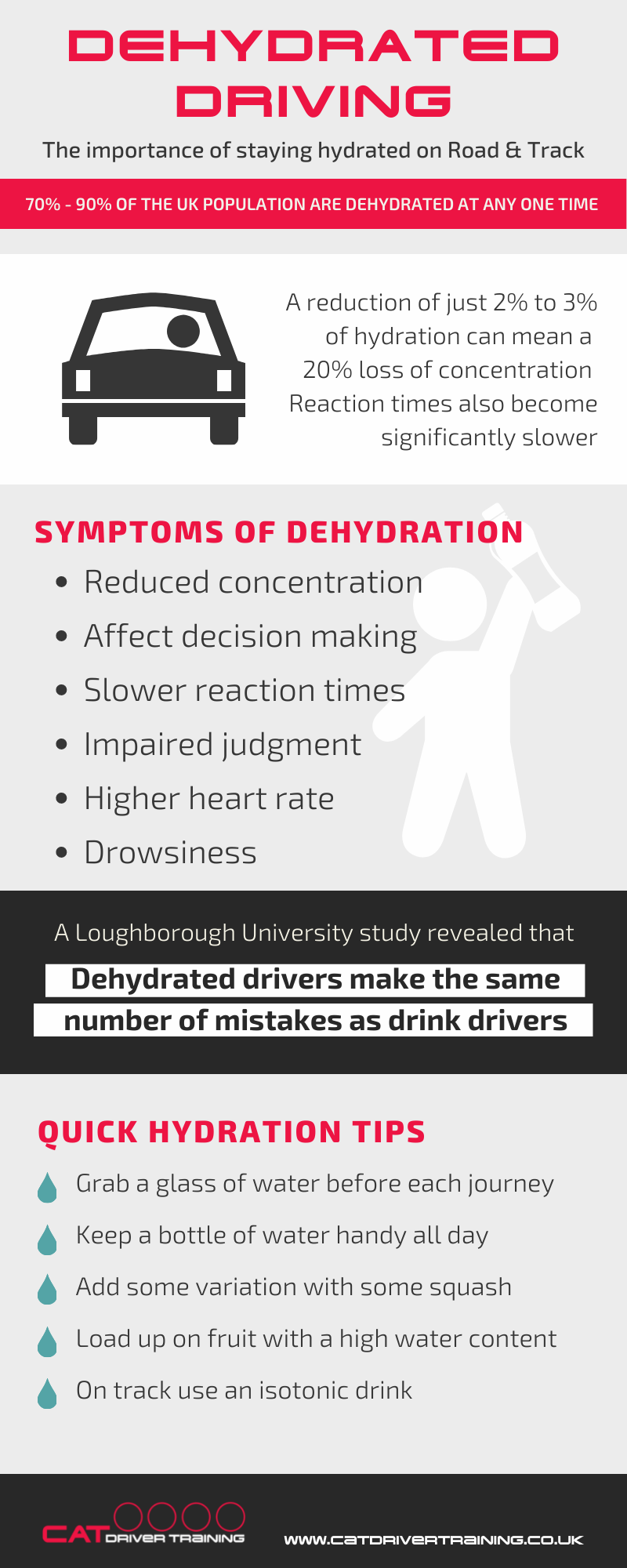

Posted: December 2, 2024
As I am writing this, it’s a barmy 27 degrees and I know in some parts of the country it’s even hotter. But the hottest place in the country on a day like today, is not in any specific geographic location, it’s in your car. Of course, most modern-day cars are fitted with air conditioning to keep the driver nice and cool on their journey.
After the first 5 minutes of driving you’ll probably have forgotten how hot it is outside and how hot you were up to the point when the aircon started to cool you off. You may have also forgotten how thirsty you were before you got into the car and that could be a problem - dehydration.
Depending on where you get your figures from, it’s estimated that an unbelievable 70 to 90% of the UK population are dehydrated at any one time, so if you’ve not had a glass of water in a while, go and grab one now.
Now we all know that on a hot day the human body uses the water we drink to turn into sweat and cool us down, but that’s not the only reason it’s important to stay hydrated, particularly in hot weather. As a whole, the adult human body is made up of approximately 60% water. Your blood of course is largely made up of water. 93% of it in fact. Your muscles and kidneys are about 79% water. Your brain and heart, 73% and even your bones are roughly 1/3 water.
That means in the very literal sense, the less hydrated you are, the less of you, you become. Less blood, less muscle, less heart and less brain and that can have a significant impact on how you perform.
Tap “dehydration in athletes” into Google and you’ll be met with a wealth of websites giving you some hard facts about the effects of dehydration on performance. Muscle strength and endurance are the key messages that come to the forefront, but you’ll also find a lot of information about how dehydration can affect your brain function.
When we’re preparing clients for track days and racing here at CAT Driver Training, we often speak of the importance of hydration.
A reduction of just 2% to 3% of hydration can mean a 20% loss of concentration. Reaction times also become significantly slower.
In tests conducted by Loughborough University back in 2015 it was found that people who were dehydrated and driving committed the same number of errors as those that had drank a couple of alcoholic drinks. It’s a fact worth remembering if you’re preparing for a day at the track, and it’s just as relevant for those making a trip to the shops.
Of course in Summer, it’s not just the heat that puts us at risk of dehydration. It’s those cheeky couple of drinks down the pub on a lovely warm summer’s evening. Now it goes without saying that drinking and driving is not an acceptable combination, so the question is, once you have returned home safely by whatever alternative means, do you remember to rehydrate yourself - not just that evening, but the next morning as well?
If you’ve been drinking in moderation, after a good night’s rest, your blood alcohol levels may be back to a safe limit but your body may still be dehydrated and that is putting you at greater risk, should you choose to get back behind the wheel. If you have been drinking, let’s say a little more enthusiastically and you become severely dehydrated, your body can take up to 72 hours to return to its normal level of hydration. Until it does, your abilities behind the wheel will be compromised.
A good practice then, is to keep yourself hydrated at all times and in particular, hydrate before you drive.
Whilst plain water is always a solid choice, other options like juice, tea, and even coffee can give you the fluids you need. It’s a common misconception that drinks containing caffeine have diuretic properties, but that’s only found to be the case in very high doses. And if you’re not a fan of drinking large amounts of liquid, even on hot days, you could always try combining your liquid intake with a good portion of fruit. Melon, grapefruit and strawberries are all made up of over 90% water. Peaches, pineapple, plums and oranges have water levels above 85%.
To help spread the word during this hot weather, we have created this helpful infographic for you to share.

Right, all this talk of hydration is making me thirsty so I’m off to refill my glass. Until next time.
Call: 01234 757 633
Email: info@catdrivertraining.co.uk
CAT Driver Training is the fast way to develop & improve authentic dynamic driving skill, technique & knowledge from the Best. OEM recognised driver training for individuals & the motor industry. As the leading UK based independent advanced performance driving skills company, we exist to make your driving experience even better. Explore your cars potential, fulfill your own. Coaching advanced road & track skills, safety driver training courses for individual driving enthusiasts & advanced driving for all facets of the motor industry. The only training company resident within UTAC's Millbrook Proving Ground in Bedfordshire, within easy reach of London, & all surrounding counties: Hertfordshire; Buckinghamshire; Oxfordshire; Nottinghamshire; Cambridgeshire; Norfolk; Suffolk; Essex; & Surrey. Clients travel from the World over & the UK to learn from the authentic evidence based dynamic driving & vehicle dynamic experts. | All Rights Reserved | Copyright 2005 – 2025
Some of the links we use are affiliate links. This means that, at no cost to you, CAT will earn an affiliate commission if you click through the link and finalise a purchase.
Designed by WHP
Coded and built by Prominent Media